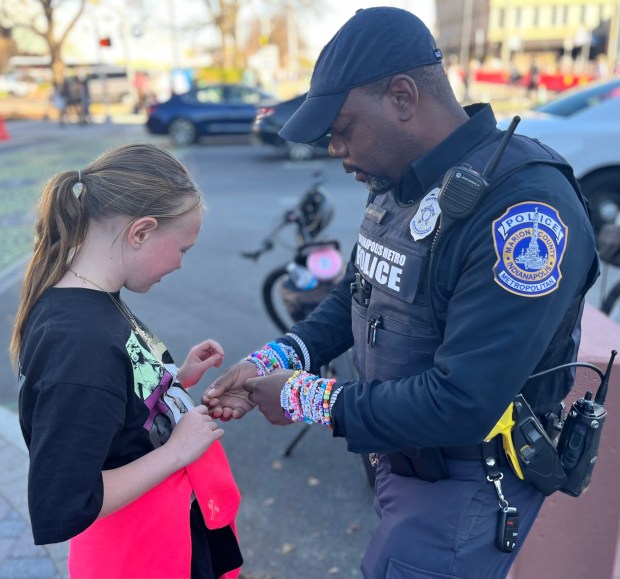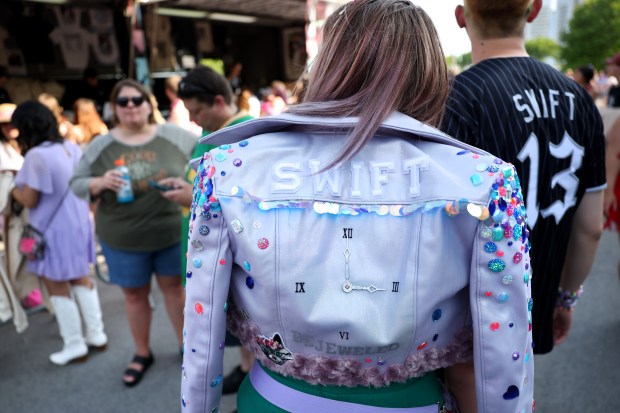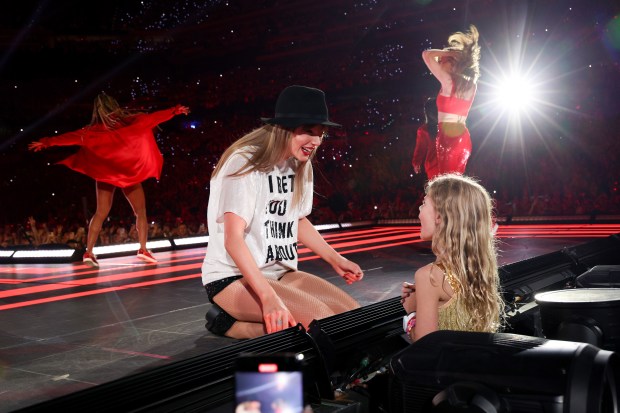INDIANAPOLIS — The end of Eras is upon us.
This won’t be the last time you hear that over the next few weeks. Taylor Swift played the final United States show on her ultra-mega-blockbuster Eras tour last weekend in Indiana. After a year and a half of concerts and almost 150 dates (including three sold-out nights at Soldier Field in Chicago), the tour concludes in Vancouver on Dec. 8.
And though you’ve likely had a lifetime fill of Taylor Swift since Eras began in 2023 — or you can never get enough and are already rallying fellow Swifties to avenge my sincere micro-plea of exhaustion — we need to consider why the Eras Tour will be remembered as a cultural milestone for decades to come, a spiritual cousin to Woodstock, a traveling micro-economy and a coming-out cotillion for the future, which, most certainly, is female.
We need to see why its influence will go on for years.
I attended the second night in Indianapolis, and like every previous night on the tour, it began with a statement: A clock appeared on a massive screen, counting down to the start of the concert, counting back from exactly 2 minutes and 31 seconds. Why so exact? Because that’s the length of the song that Swift has taken the stage to at every show on the Eras Tour: Lesley Gore’s furious, gauntlet-throwing “You Don’t Own Me.”
And don’t tell me what to do
Don’t tell me what to say
And please, when I go out with you
Don’t put me on display, ‘cause
You don’t own me
Now picture 69,000 people, nearly all women, some elderly, some in elementary school, many in their teens and 20s, bedazzled, screaming that, thrusting fists, singing with alone-in-the-shower energy, not because they are collectively into AM pop radio hits of 1963, but because they felt it. And since little about the Eras tour is spontaneous, they expected it. Indeed, this is the first and most important lesson to pull from the Eras Tour:
1. Fans Are the Show Now.
A woman in her mid-20s sat in front of me wearing a ballet tutu so stiff and wide it flowed gloriously across nearby seats and even out into the aisle. It took up space. When Lesley Gore’s voice landed, the woman leaped from her chair and belted the lyrics skyward, howling at the soaring roof of Lucas Oil Stadium, usually home to NFL football. This woman was surprising and funny, angry and creative and thoughtful. She was like performance art herself, employing the canvas of the Eras Tour as both a catalyst and a sandbox. And again, she was just one out of 69,000 fans. After Swift played “Champagne Problems” alone at a piano, midway through the show, Swift stood for an ovation that went on 2 minutes and 30 seconds. It was endless, and from the practiced look of surprise and humility on Swift’s face during the ovation, expected. But never for a moment did I think that ovation was about Swift.
It was about a fandom reveling in its own stamina and voice, and Swift graciously playing the sounding board. Consider that ballet costume — a nod to an outfit Swift wore in the “Shake It Off” video. Here was a concert closely resembling a fan convention. Or a cosplay showcase. I saw someone dressed like Jake Gyllenhaal (a Swift ex), and someone dressed as the scarf Swift was rumored to have left at his apartment when they broke up. I saw women dressed as Christmas trees, because Swift grew up on a Christmas tree farm. I saw a man playing a banana, because there is a video of Swift having trouble with a banana after undergoing Lasik surgery. It was shot by her mother, who finds her daughter in bed trying to eat a banana, looking very spaced out.
“I’m not asleep,” Swift tells her mom, “my mind is alive.”
I also saw someone in a shirt that read: “I’m not asleep. My mind is alive.”
If you didn’t get those references … well, then what were you doing there?
Grateful Dead fans, Bruce Springsteen fans: You probably see similarities. Swifties without tickets roamed Indianapolis streets before the shows, holding a finger in the wind. That’s classic Deadhead for “I need one ticket.” Also known in Dead-ese as “a miracle.” Music may be the organizing force, but since we more or less know what we’ll hear, the music is merely a way into a coded universe constructed partly by that audience. Swift herself spends a huge part of the show staring directly into cameras, as if she’s staring at you alone. That’s when she isn’t staring into the crowd, smiling and winking — playing, at least, an answer to decades of self-congratulatory concert gods.
2. The Age of the Impersonal Pop Star is Over.
The irony of the Eras Tour is that even as it made Swift a global force, she comes off human in the show, not a caricature or even, despite all the theater involved, a posturing idol. In fact, whether you believe her or not, a chunk of her show features Swift singing that not everything is about her. I write that despite that, a few blocks from Lucas Oil Stadium, a Marriott installed a massive Taylor Swift on its facade, a mural rising nearly as high as the 34-story hotel itself. You could see this Tay-Zilla from clear across downtown. That’s not her doing. But even when Robert Plant was whole-heartedly drunk on his own glow, playing a golden god on Led Zeppelin tours, he wouldn’t have dreamed of such lionizing. Then again, no one sought his presidential nod — or accused him of interfering in politics.
He was also never accused of single-handedly inflating ticket prices, destroying the environment by using private jets, being a capitalist pig in service to an elitist power structure, dating racists or failing to call for a cease fire in the Middle East. Fairly or not, Swift has heard of all of that and way more — why can’t she show dogs some love, too?
My point is, if even Taylor Swift can fake a real smile night after night — as well as laugh a laugh that sounds like a genuine laugh — what excuse do other pop stars have anymore? Think about that next summer when Oasis holds you emotionally at arm’s length. A woman sitting behind me at the show had Neil Young lyrics scrawled on her arm in marker. I asked her why. She said Taylor used to do this before concerts, so this fan does this a lot, whenever she feels good, sad, anything, she does it for herself — to remind her to feel something.
3. The Only Universal Culture Left is Female.
There was a moment in the Eras Tour reserved for variety, a two-song bit where the show leaves its well-oiled track and alters nightly. Anything can happen, but typically Swift plays a medley on guitar followed by a medley on piano. More surprising, the night I attended, was the red, white and blue dress Swift wore during those songs, the colors less flag-like than melting together. It came, of course, days before the election. She paired that with a song titled “The Prophesy.” The refrain: “Who do I have to speak to / About if they can redo the prophecy?” It’s not a political song but briefly became one.
It reminded me of the Olympics, how politics are present but often unspoken. The Eras Tour itself was like the Olympics, from the stage surface itself doubling as a screen to parades of dancers who enter the stadium with billowing sails above their heads. Like the Olympics, the Eras Tour was also that rare 21st century culture most Americans are aware of and sometimes form opinions about, even if they never bothered to watch. It’s like mainstream culture before streaming, iPods, the internet and TikTok; it’s of a piece with “M*A*S*H*” and” “Star Wars” and Michael Jackson. It’s closest in cheery spirit to Paul McCartney (a Taylor BFF), though a reminder pop music right now is named Olivia and Sabrina and Lana and Charli, decidedly female, crafted by females for females.
Swift thanked fans for all the “ceremonial traditions” created during the tour. She could have meant the Deadhead-esque caravans. (I met fans from Maine, Colorado, New York, but few from Indiana.) She could have meant how many women took off shoes and danced in bare feet. (Three-plus hour shows will do that.) But probably she meant the bracelets, beaded words spelling songs and albums, circulating throughout the Taylor-verse, traded or often gifted, among fans. I saw very few Indianapolis police officers or stone-faced security dudes without an arm covered in bracelets, like notes of solidarity. I passed a restaurant table covered in bracelets, all lined up orderly in rows.
“Wow,” a passerby said, “you made a lot.”
“I went nutso,” the bracelet maker replied.

Music writer Rob Sheffield has a charming, insightful new book “Heartbreak is the National Anthem: How Taylor Swift Reinvented Pop Music” that includes a telling story about Swift as a kid, pre-social media, smitten with LeAnn Rimes. She presses close to Rimes after a show: “LeAnn, did you get my letter?” And Rimes says: “I sure did, Taylor.”
“For Taylor,” Sheffield writes, “that was the primal scene of instruction.” Rimes, he explains (cheekily), “warped this child into being the best to ever do what LeAnn did.”
Meaning, Rimes took a young girl seriously as a person, and Swift made it a culture.
4. Concerts Need to Tell Stories Now.
If there’s a reason why what happened onstage during the Eras Tour came across less phony than it probably sounded in descriptions, that’s because the production takes the concept of theater seriously, too. Beyonce does it. Bowie did it. Springsteen spun long intimate stories of family that went on the length of songs. Swift works this muscle, too.
Theatrical doesn’t have to mean fake, of course. It was a spectacle but there were a lot of homes and rooms on that stage — a rustic cabin in one segment, an office building during another. You could feel your attention being pushed in, then out — zooming for closeup, circling the grounds. Sometimes you were reminded of high school, other times gender inequality. There were knowing cliches and painful realizations and recognitions of privilege. But the plot never changed: The Eras Tour, bottomline, was the story of how a girl grows into a woman, and all the heartache and delight that comes with that time.

It also paradoxically makes Swift a character in her own story, an avatar for herself. Some of the conversations I heard on the way out of the show included: Does Taylor Swift cry like I cry? Does Taylor Swift scream in the car?
The Eras Tour was a lot of world building for a pop show, but then: She’s almost 35, the same age Springsteen was when he told stories on the “Born in the U.S.A.” tour about parental feuding and the struggles of returning Vietnam vets. He asked stadiums to question Ronald Reagan and blind faith, and Swift screams about blind faith and a boyfriend who talks about his childhood and carries a “(Bleep) the Patriarchy” keychain. That many of her young fans even know the word “patriarchy,” that’s a sign of progress.
5. The Past is Never Past.
Eras end messily, trailing slime like a snail.
That was the clever conceit of the tour: Each show was divided into acts, or eras, representing moments in life. When I first heard this, it sounded self-congratulatory, grandiose. Until I recognized The Beatles lasted a decade, and Swift is 17 years into an ongoing career. Her evolution hasn’t been as dizzying as veering from “Love Me Do” to “Tomorrow Never Knows,” but she’s still young, savvy enough say something about life that also nods to the future of live music: We are the eras we embody yet we still carry every era we have been, all the time. We are more like a medley than a song.
Performers have always banked on a mix of new and old songs but the Eras Tour suggests the way streaming services like Spotify and Apple Music present a body of work as a flat constant, playing everything all at once, shuffling evolution. Reinvention is real but past selves remain, it says. Regret and pride live beside pettiness and silliness. At one point in the show, Swift seems to struggle against a series of past Taylors trying to free themselves from glass cages. Corny, but telling: The kind of extended music career that allows enough patience to change shape and sound looks increasingly rare.
Who is still around, making relevant music, with enough material, ambitious enough for something like this, a nostalgic concert that points to the future? The Eras Tour became its own weather system, its own touring chamber of commerce, its own bit of folklore. It’s maybe never to be repeated. It just contained too much. It became too big. Taylor Swift played, no joke, 47 songs at the show I saw, in part or whole. At least one was 10 minutes long. By the end I was well into my exhaustion era. But leaving the stadium, I heard delight, a teenager singing to herself. She wasn’t singing one of those 47 songs. She was singing Lesley Gore:
I’m young and I love to be young.
And I’m free and I love to be free.

cborrelli@chicagotribune.com



